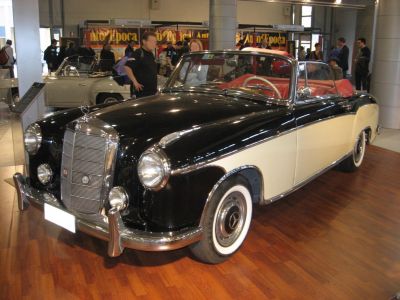 1958 Mercedes-Benz W128 Cabriolet Dimensions, Size & Specs
1958 Mercedes-Benz W128 Cabriolet Dimensions, Size & SpecsMeasurements of the 1958 Mercedes-Benz W128 Cabriolet, engineered for optimal performance and comfort
| Dimensions | |
|---|---|
| Length: | 4700 mm185.0 in15.4 ft |
| Width: | 1790 mm70.5 in5.9 ft |
| Height: | 1530 mm60.2 in5.0 ft |
| Weight Specifications | |
| Curb Weight: | 1410-1430 kg3109-3153 lbs |
| Maximal permitted Weight: | 1810-1830 kg3990-4034 lbs |
The Mercedes-Benz Ponton W128 Cabriolet was produced between 1958 and 1960 as a luxurious, open-top version of the celebrated Ponton series. This classic cabriolet embodies the elegance and engineering excellence characteristic of Mercedes-Benz in the late 1950s. Measuring 4700 mm (185 inches) in length, 1790 mm (70.5 inches) in width, and 1530 mm (60.2 inches) in height, the W128 Cabriolet offers a balanced and graceful presence on the road. The car’s curb weight ranges from 1410 to 1430 kg (3109 to 3150 lbs), with a maximum weight between 1810 and 1830 kg (3991 to 4037 lbs), reflecting its solid construction and premium build quality typical of the era. The cabriolet body style combines a spacious yet compact footprint that is both stylish and practical, ideal for enjoying open-air driving. As part of the Ponton family, the W128 continues the legacy of the post-war Mercedes models that were known for their pioneering safety features and distinctive ponton, or pontoon, styling with smooth, rounded edges. The Mercedes-Benz Ponton W128 Cabriolet remains a sought-after classic vehicle, boasting refined dimensions that harmonize vintage charm with functional design. This generation’s size and weight make it a comfortable driver on modern roads, while its historical significance and classic Mercedes flair appeal to enthusiasts and collectors alike.
Discover the standout features that make the 1958 Mercedes-Benz W128 Cabriolet a leader in its class
Have a question? Please check our knowledgebase first.
The Mercedes-Benz Ponton W128 Cabriolet measures 4700 mm (approximately 185 inches) in length, making it a fairly long classic cabriolet. Its width stands at 1790 mm (about 70.5 inches), providing a moderately wide stance that enhances road presence and interior space. The height is 1530 mm (around 60.2 inches), which is typical for a cabriolet of its era, balancing aerodynamic design with comfort. These dimensions contribute to the car’s elegant, sleek profile that was luxurious and distinctive in the late 1950s.
The curb weight of the Mercedes-Benz Ponton W128 Cabriolet ranges between 1410 and 1430 kilograms (approximately 3109 to 3151 pounds). This moderate weight is fairly typical for luxury cabriolets built during the 1950s, combining solid build quality and robust construction. The weight influences the car's stability and road handling, providing a steady and comfortable ride. Although heavier than modern lightweight cars, the Ponton’s chassis and suspension were engineered to accommodate this weight, resulting in refined driving dynamics that balance comfort with responsiveness on winding roads or city streets.
The maximum weight capacity of the Mercedes-Benz Ponton W128 Cabriolet ranges from 1810 to 1830 kilograms (approximately 3991 to 4037 pounds). This figure includes the curb weight plus passengers, cargo, and any additional load the car can safely carry. Understanding the maximum weight helps in maintaining optimal vehicle performance, safety, and durability. Exceeding this weight could compromise suspension performance, braking efficiency, and overall handling characteristics. Therefore, adhering to this limit ensures the longevity of the vehicle’s mechanical components and a safer driving experience.
Yes, the Ponton W128 Cabriolet fits comfortably into a standard residential garage. Given its length of 4700 mm (185 inches) and width of 1790 mm (70.5 inches), the car's dimensions are manageable for typical garage sizes, which generally accommodate vehicles up to around 6 meters (approximately 236 inches) in length and 2.5 meters (98 inches) in width. The height of 1530 mm (60.2 inches) also presents no clearance issues for standard garage doors, which are often well over 2 meters (79 inches). This makes parking and storing the classic cabriolet convenient for owners.
Compared to its predecessor within the Ponton lineup, the W128 Cabriolet retained a similar length but featured subtle design and size refinements. The earlier Ponton models, such as the W121 or W120 sedans, were slightly shorter or narrower, while the W128 maintained a length of 4700 mm (185 inches) and width of 1790 mm (70.5 inches), emphasizing a more luxurious and spacious cabriolet design. The height was modestly increased to accommodate the convertible mechanism and improve comfort. Overall, the W128 Cabriolet offered a slightly more substantial presence on the road, reflecting Mercedes-Benz's focus on luxury and style evolution during 1958-1960.
The Mercedes-Benz Ponton W128 Cabriolet's dimensions position it comfortably among similar luxury convertible cars of the late 1950s. Its 4700 mm (185 inches) length and 1790 mm (70.5 inches) width provided an elegant and generous size, comparable to contemporaries like the Jaguar XK150 or the Cadillac Eldorado convertible. While some competitors might have been slightly longer or wider, the Ponton W128 stood out for its balanced proportions and refined German engineering. Its manageable height of 1530 mm (60.2 inches) was standard, allowing the cabriolet to maintain sleek aesthetics without bulkiness.
While exact interior space figures for passenger legroom and cargo capacity of the W128 Cabriolet are less formally documented, the vehicle’s exterior dimensions (4700 mm length, 1790 mm width) indicate a roomy four-seat cabriolet configuration typical for luxury vehicles of the time. The wide cabin offers ample shoulder room, comfortably seating four adults. The convertible design reduces rear headroom slightly when the top is up but enhances open-air experience with the top down. The trunk space is modest due to the convertible roof mechanism but sufficient for weekend luggage or smaller loads, reflecting the balance between style and practicality.
Weighing in at 1410 to 1430 kg (3109 to 3151 lbs), the Ponton W128 Cabriolet carries considerable heft by modern standards. This influences fuel economy, as heavier cars typically require more energy to accelerate and maintain speed. For a 1950s luxury car with a large engine, this meant moderate fuel consumption in the range typical for its class and era. Performance-wise, the weight contributes to stable handling and smooth ride quality but can slightly reduce acceleration and agility compared to lighter sports cars. Nonetheless, the engineering balance offers an enjoyable cruiser experience with responsive dynamics for its category.
With a length of 4700 mm (185 inches) and width of 1790 mm (70.5 inches), the Ponton W128 Cabriolet is relatively large for urban parking, especially in tight city spaces. Drivers may find maneuvering in narrow streets or compact parking spots more challenging than with smaller cars. However, its moderate height of 1530 mm (60.2 inches) allows parking garages and covered spaces to accommodate it comfortably. Owners often appreciate the car’s stylish presence but should be mindful of its footprint when parallel parking or utilizing smaller city garages. Awareness of the turning radius and cautious driving aid urban usability.
The Mercedes-Benz Ponton W128 Cabriolet stands out for its refined blend of classic 1950s styling with advanced engineering for the era. Unlike earlier open variants, this generation features a more streamlined, aerodynamic body design and a fully integrated convertible top that enhances both aesthetics and weather protection. The Ponton W128’s engineering improvements include robust suspension systems tuned for comfort, dependable mechanical components, and a luxury-focused interior that emphasizes craftsmanship. Its combination of classic elegance and technical sophistication made it a flagship cabriolet, representing Mercedes-Benz’s commitment to quality and luxury during its 1958-1960 production period.
Discover similar sized cars.

| Production: | 1956-1959 |
|---|---|
| Model Year: | 1956 |
| Length: | 4700 mm185.0 in |
| Width: | 1790 mm70.5 in |
| Height: | 1530 mm60.2 in |
